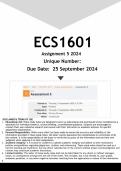,
, UNISA 2024 ECS1601-24-Y Online assessments Assessment 5
QUIZ
Started on Thursday, 19 September 2024, 3:31 PM
State Finished
Completed on Thursday, 19 September 2024, 4:09 PM
Time taken 38 mins 20 secs
Marks 19.00/20.00
Grade 95.00 out of 100.00
Question 1
Correct
Mark 1.00 out of 1.00
The introduction of the foreign sector in the Keynesian model______ the slope of the consumption function. As a result, the
multiplier becomes______.
a. increases; larger
b. reduces; smaller
c. increases; smaller
d. reduces; larger
When the foreign sector is introduced, the slope of the consumption function is reduced further. As a result, the multiplier
becomes even smaller. Please see example in page 156 of the prescribed book.
, Question 2
Correct
Mark 1.00 out of 1.00
The value of the multiplier is necessarily increased if
a. the marginal propensity to consume increases and the marginal propensity to import falls.
b. the marginal propensity to consume falls and the tax rate falls.
c. the marginal propensity to consume and the marginal propensity to import rise.
d. the income tax rate falls and the marginal propensity to import rise.
In the discussion of the previous question, we explain that the multiplier will increase when the marginal propensity to
consume increases, when the tax rate decreases and when the marginal propensity to save decreases.
When the marginal propensity to import increases, it means that a larger part of an increase in income is not spent on goods
produced in our economy, thus decreasing the multiplier effect of any increase in autonomous spending. Thus, the multiplier
will increase when the marginal propensity to import decreases. This relationship is illustrated by the following formula from
section 6.7: ∝ =1/(1-c(1-t)+m) + - - Where c is the marginal propensity to consume, t is the tax rate and m is the marginal
propensity to import. The signs underneath each symbol indicate its relationship with the multiplier (α). c has a positive
relationship with α (see the + sign under c).
A positive relationship means that an increase in c will increase α. Conversely t and m have a negative (or inverse)
relationship with α. This means that if the tax rate or the marginal propensity to import increase then the multiplier will
decrease in size. The marginal propensity to save also has a negative relationship with the multiplier since an increase in s
must mean a decrease in c, since c + s = 1. The sizes of the changes are not mentioned in the, therefore we can only assume
that the value of the multiplier increases when both variables mentioned in an option has a positive effect on the size of the
multiplier. An increase in the marginal propensity to consume and a decrease in the marginal propensity to import will
definitely increase the multiplier, regardless of the size of the changes in the propensities.
Question 3
Correct
Mark 1.00 out of 1.00
If the government increases its expenditure, but keeps the tax rate constant, we will find that consumption expenditure______,
total tax revenue_____, and investment spending______.
a. stays the same, stays the same, stays the same
b. increases, stays the same, stays the same
c. increases, increases, stays the same
d. increases, increases, increases
Remember that our frame of reference is the simple Keynesian model. An increase in G leads to an increase in income (Y) as
the increase in expenditure has to be received by some factors of production as income. The increase in income will result in
an increase in induced consumption and also an increase in the amount of tax that has to be paid by the receivers of the
higher income. Investment spending, however, is autonomous and does not depend on the income level and will therefore not
be affected. Therefore, the sentence should read as follows: “If the government increases its expenditure, but keeps the tax
rate constant, we find that consumption expenditure increases, total tax revenue increases, and investment spending stays
the same.





